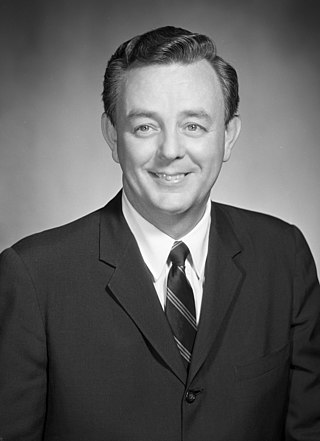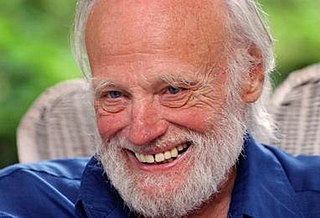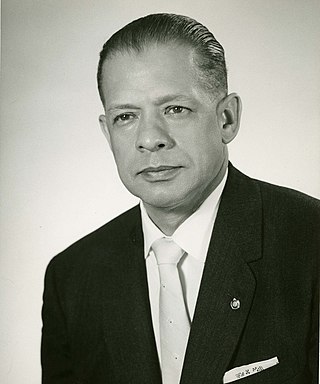
James Terry Sanford was an American lawyer and politician from North Carolina. A member of the Democratic Party, Sanford served as the 65th Governor of North Carolina from 1961 to 1965, was a two-time U.S. presidential candidate in the 1970s, and served as a U.S. senator from 1986 to 1993. He was a strong proponent of public education and introduced several reforms and new programs in North Carolina's schools and institutions of higher education as the state's governor. From 1970 to 1985, Sanford served as the president of Duke University.

The Appalachian Regional Commission (ARC) is a United States federal–state partnership that works with the people of Appalachia to create opportunities for self-sustaining economic development and improved quality of life. Congress established ARC to bring the region into socioeconomic parity with the rest of the nation.

Hargrove "Skipper" Bowles Jr. was an American Democratic politician and businessman, based in Greensboro, North Carolina.

John Marsden Ehle, Jr. was an American writer known best for his fiction set in the Appalachian Mountains of the American South. He has been described as "the father of Appalachian literature".
The North Carolina Fund was a series of experimental programs conceived at the request of North Carolina governor Terry Sanford, who was aided by the writer John Ehle. Its director, George Esser, was appointed in 1963. It was created as a non-profit corporation to operate for five years only, with a mandate to create experimental projects in education, health, job training, housing, and community development.

Ann George Atwater was an American civil rights activist in Durham, North Carolina. Throughout her career she helped improve the quality of life in Durham through programs such as Operation Breakthrough, a community organization dedicated to fight the War on Poverty. She became an effective activist and leader when advocating for black rights, such as better private housing. Atwater promoted unity of the working-class African Americans through grassroots organizations.
Jacquelyn Dowd Hall is an American historian and Julia Cherry Spruill Professor Emerita at the University of North Carolina at Chapel Hill. Her scholarship and teaching forwarded the emergence of U.S. women's history in the 1960s and 1970s, helped to inspire new research on Southern labor history and the long civil rights movement, and encouraged the use of oral history sources in historical research. She is the author of Revolt Against Chivalry: Jessie Daniel Ames and the Women’s Campaign Against Lynching;Like a Family: The Making of a Southern Cotton Mill World and Sisters and Rebels: The Struggle for the Soul of America.
The Royal Ice Cream sit-in was a nonviolent protest in Durham, North Carolina, that led to a court case on the legality of segregated facilities. The demonstration took place on June 23, 1957 when a group of African American protesters, led by Reverend Douglas E. Moore, entered the Royal Ice Cream Parlor and sat in the section reserved for white patrons. When asked to move, the protesters refused and were arrested for trespassing. The case was appealed unsuccessfully to the County and State Superior Courts.
Malcolm X Liberation University was an experimental educational institution inspired by the Black Power and Pan-Africanist movements and located in Durham and Greensboro, North Carolina. Howard Fuller, Bertie Howard, and several other African American activists in North Carolina founded the school in response to the 1969 Allen Building Takeover on Duke University's campus. It operated from October 25, 1969 to June 28, 1973. One of the main reasons the school closed was that political conflicts damaged the school's reputation, making it more difficult to acquire funding. Due to financial setbacks, the school operated for only three years.

Lincoln Hospital was a medical facility located in Durham, North Carolina founded to serve the African Americans of Durham County and surrounding areas. With original hospital construction financed by the Duke family, Lincoln served as the primary African American hospital in Durham from its opening in 1901 until 1976, when it closed and transferred its inpatient services to Durham County General Hospital.
Louis Austin (1898-1971) was an African-American journalist, civic leader and social activist. Austin purchased The Carolina Times in 1927 and transformed it into an institution that aided African Americans in their fight for freedom and equality in North Carolina. He used a new approach to civil rights issues in Durham, incorporating lower and middle class blacks, unlike the moderate, accommodationist approach of the black elite in Durham during this time. Austin's unusual strategy of advocating for the majority of blacks to have a voice in society succeeded in galvanizing a broader segment of the African American community in Durham to act for social change. Austin's approach to black activism helped lay the groundwork for the modern Civil Rights Movement in Durham in the late 1950s and 1960s, which also encouraged lower-income blacks to become politically active. His strategies—which were once considered too radical by his peers—allowed Austin to maintain his influence in Durham well into the 1950s and 1960s. In doing so, Austin created a lasting impact for Durham.
Benjamin Sylvester Ruffin, also known as Ben Ruffin, was an African American civil rights activist, educator, and businessman in Durham, North Carolina.
Howard Fuller is a civil rights activist, education reform advocate, and academic. He is best known for the community organizing work he did in Durham, North Carolina, as an employee of Operation Breakthrough, and as a co-founder of the Malcolm X Liberation University in 1969. In the 1970s, Fuller adopted the name Owusu Sadaukai, organized several national African Liberation Day celebrations, and was one of the foremost advocates of Pan-Africanism in the United States. Decades later, Fuller rose again to national prominence as one of the leading advocates for school vouchers. He served as the superintendent of Milwaukee Public Schools from 1991-1995 and is currently a distinguished professor of education, and founder/director of the Institute for the Transformation of Learning at Marquette University in Milwaukee, Wisconsin.
The People's Alliance (PA) is a progressive grassroots consumer watchdog organization in Durham, NC. It comprises three legally separate organizational entities: The People's Alliance, 501c(4) led by a steering committee, founded in 1975; The People's Alliance Fund, 501c(3) led by a board of directors, established in 1980; and The People's Alliance PAC – a political action committee established in 1982. The group participates and funds local initiatives, particularly to help low-income families obtain access to quality education, housing, and transportation.
Locked in the Poorhouse: Cities, Race, and Poverty in the United States is a 30-year update of the final report of the National Advisory Commission on Civil Disorders, co-authored by former Kerner Commissioner, Senator and Milton S. Eisenhower Foundation Chairman Fred R. Harris and Eisenhower Foundation President Alan Curtis. The book was released in 1998 with a companion volume, The Millennium Breach.
Social mobility in South Africa refers to the movement of South Africans from one social class to another. it is the study of upward socio-economic change in status achievable by South Africans from generation to generation.
The Good Neighbor Council was an effort in North Carolina proposed by Governor Terry Sanford to fight racial segregation and encourage the employment of Black people in the state. David S. Coltrane was the first chairman and director of the Good Neighbor Council.

John Hervey Wheeler was an American bank president, businessman, civil rights leader, and educator based in North Carolina. Throughout his life, Wheeler was recognized for his accomplishments by various institutions across the country. John H. Wheeler started as a bank teller at Mechanics and Farmers Bank, and worked his way up to become the bank's president in 1952. In the 1960s, Wheeler became increasingly active in United States politics, carrying several White House positions appointed by Presidents John F. Kennedy, Richard Nixon, and Lyndon B. Johnson.

John Wesley Winters Sr. was an American real estate developer, politician, and civil rights activist. A member of the Democratic Party, he served on City Council of Raleigh, North Carolina, from 1961 until 1967 and in the North Carolina Senate for the 14th district from 1975 until 1977.
James Andrew Felton was an educator, counselor, community leader, and author in northeastern North Carolina. His decades of activism exemplified black organizing during the “long civil rights movement” through efforts to ensure equal rights for African Americans, merge North Carolina’s segregated teacher associations, improve housing conditions in the state’s Black Belt, and preserve black history.







